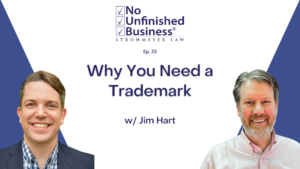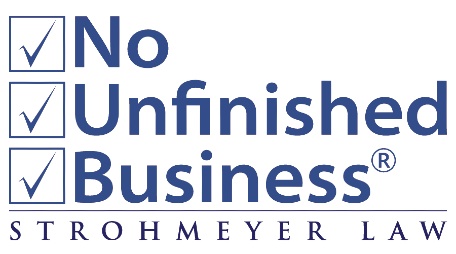How to Stress-Test Your Estate Plan (And Why to Do It NOW)
Stress-Testing Your Estate Plan
You’ve got an estate plan, and you don’t plan on dying soon. That’s great! But if something did happen unexpectedly, does that plan still fit your needs and goals? Is your situation the same as it was when you drafted those documents?
John Strohmeyer has some thought exercises you can do to stress-test your current plan, and find any gaps or inconsistencies NOW, before there’s an issue.
– Periodically check value of assets and distribution
– Find original documents
– Find your actual assets
– Check for unclaimed property
– Do we need to adjust who is named in the plan?
– How are people going to react to your plan?
– How often should you examine, re-examine, or change your plans?
—–
VIDEO TRANSCRIPT:
You’re not planning on dying anytime soon, but that doesn’t mean it’s not a good chance for you to take a look at what your plan is and what will happen. Hi, I’m John Strohmeyer with Strohmeyer Law, and today we’re talking about stress testing your estate plan.
Why do I need to do this?
The problem is that many people have their plans put in place once and treat it as though it’s fine. It’s like a couch they bought that one time for their house and it’ll work in the house they have now, it’ll work in the house they have five years from now, and it’ll probably work in the house that they have 20 years from now.
The problem though, is we always want to be taking a look at this to make sure we know, does this plan work? What happens if you die? What happens if you’re incapacitated? And once we know what will happen when those two situations occur. We want to be taking a look and saying, “Is this what you want to happen?” If it’s not what you want to happen, there’s no better time than now to start taking a look at things and making those changes to ensure that your plan, whatever that might be, gets carried out. I’d like to say that in doing this for over a decade, nobody has ever asked me to help them create a mess. So, what we’re looking at today is how can we avoid those messes now by running through our plan and seeing what will happen.
Where do we start?
Let’s start with the assumption that your estate plan really isn’t a set it and forget it. It’s like flying a plane. The plane takes off and we aim to wherever that destination is. But, as we’re going along, we might need to be making small changes to ensure that the plane goes according to plan, so that the plane actually lands where we want it to with a nice, mess free transition when you pass.
So, this means we’d rather make smaller changes on a more frequent basis to keep things in line rather than large changes every few years or so. When there’s a big upheaval, we’d rather keep things smooth and going in the right direction. Why? It’s easier for everybody. And it means there’s less work to be done when we’re getting things done.
First, we want to think about what do our documents say and what happens to our stuff for when you pass. Who should get those assets? Are they going to get too much? Have you put in place a plan that will give too much value to one person? It’s possible that you may have set up something with a formula or in a kind of an embedded formula that isn’t working out as well.
Values can change
If you wanted to give all of your Exxon stock to one child and have the other two children split what’s left, what happens if the value of the Exxon stock goes way up? What if it goes way down? Is that still okay? Should they be getting an equal amount or, really, are you trying to give them a particular asset?
I’ve seen it before, where a client wants to leave the family business to one child and then have the other children basically split whatever’s left. That’s fine. And there’s nothing wrong with doing your plan that way, but we always want to make sure that, as we’re going along, the value that is being transitioned is going to be equivalent.
We don’t want to make bigger problems for the family by having the child who’s getting the business get too much in value or the child who’s getting only the business, perhaps, getting nothing in value because the company went out of business either way. We want to be taking a look at it to make sure that everybody’s getting an appropriate amount.
Where are the original documents?
Next, we want to make sure that, for whatever documents we’re going to be following, we know where we can find the originals. Part of the plan is making sure we know which documents are going to be in charge and will be guiding our decisions. So, we want to make sure that we know where they are and where we can find them when we need them. They’re going to be a lot of people who want to see the originals. Therefore, we want to know where they are and how to find them when we need them.
List of your assets
Step three, in this stress test, is can they find your assets. Is there a good list? Now is as good a time as any to make sure that you’ve got a good list of all your assets so people know where to find things when you pass. There’s not a central repository of knowledge on things like life insurance and annuities. So if they can’t find it, there’s a good chance that they’re going to not find it. So you want to make it as easy as possible for them to find it.
Unclaimed property
While we’re thinking about finding missing assets, we also want to take the time to claim any unclaimed property that may be held by the state. We routinely check for this when we have new clients come in, not only for estate planning, but also for probate. Why is it good to check? To make sure we know who and what is out there to ensure that we can grab all of those assets.
Look, if you have something that’s wound up in the state’s unclaimed property, a depository, that’s your property. You should go ahead and grab it. While we’re looking at things, we want to make sure that we know what’s in there. And, so, we can grab that as well. Finally, how are people going to react to this plan?
Think about personalities
When you go through the plan, you want to start thinking about the personalities involved, not only who are the beneficiaries, but you want to think about who else is going to be involved? Trustees, executors, administrators, homeowners of your business. How are they going to react? When they see this plan, is a business owner going to be okay with being in business with one of your children?
Will your company documents allow for you to transition your interest to a trust for your spouse’s benefits? When you look at all of this, it’s important to know what’s going to happen and how are the people going to react? Because, if we can anticipate what those reactions will be, we can start thinking about ways to make it easier for them to either let them know now to avoid a problem later, or maybe we want to change the plan to avoid that problem all the way.
Stay the course?
So, in thinking of these questions, we’re always going to take a look at it asking, “Do we stay the course?” Once we’ve taken a look at it, one, we can stay the course. Two, we can make some incremental changes, or, three, we may even need to scrap the whole plan and start over. All of this is going to say, we need to look at things and know what’s going to happen. Now when people say, when should I be doing this? It’s something that should be happening on a regular basis once you know what your plan is. You can bring it up and think about it at any time to know what can and should be happening beyond that.
When should I make changes?
There are some rules that I tell my clients of when they should be looking at their plans and when they should be making any sort of changes. Reason number one: to change your plan. If you have new people who are going to be a part of your plan, that’s a good reason to come in and get things updated.
Now, this can be, you’ve got somebody who’s a better person to serve as an executor or trustee or one of your agents under a power of attorney. It could be that you’ve got somebody who’s going to take better care of your children if you’re not there to do that. And you want to make sure to update those names.
Likewise, the flip of this is if there are people who need to be taken out of your plan, either because they should no longer receive a gift, or you want to make sure that they’re not named as a fiduciary to manage assets for whatever reason, or you may have named your parents and it’s just no longer feasible for them to be the person in charge of your plan if you pass. So, changes may be people coming into your life who should be a part of your plan, as well as people who are leaving your life for whatever reason. In this situation, we need to make sure that they’re taken out of the plane.
Finally, if you have had any significant change in your assets, that’s always a great time to review the plan to see if anything should be different. This is not going to be, “I bought five new shares of Exxon stock and I want to make sure that that gets updated.” That value probably hasn’t changed much in terms of your overall plan, but this could be I received a substantial inheritance from my parents. We need to make sure that we’re not missing some tax opportunities with this. This may also be our assets have gone down, we’re in retirement, and we’re spending less.
And we want to make sure that we are giving the right amounts to the right places. It may also be that if your tax planning is multiple years old, you want to think about how can we make sure that we’re sending assets in the right place? One of the problems with tax plan wills from 10 to 15 years ago is that they assumed that the exemption amount was much smaller than it is now.
The problem, or the problem that was being solved, is we wanted to send most of the assets to the surviving spouse using a marital deduction clause. But, now the exemption is currently $11.7 million. And with that looking to stay high for at least the next few years that may mean a substantial portion of the assets skips the surviving spouse and goes somewhere else. Take look at this and make sure this is the right answer and is going to be something we want to do as part of the plan. This is just to make sure that we’ve gone through and seen what will happen. So, beyond that, checking in just every few years (every three to five years) is common advice. Really, every family is going to be different. To have a three to five year timeline to come back and take a look at those documents and make sure your plan is still in place is a good way of looking at it.
In conclusion
So, with all that in mind, what we want to think about is when and how can we be taking a look at our plan to make sure that everything works right? We want to go through, put the plan through its paces to make sure that when we die, the assets are going to go where we want and we’re not going to be causing any problems.
What happens to your assets? Where are your assets? Can you find your documents? Are the people you’ve named the right people. Do you need to change some people in or out because they no long because you don’t have the right mix of people. And how long has it been since you last took a look at your plan?
If it’s been more than three years, you probably want to reach back out to your estate planner and other advisors to make sure that what you have in place isn’t going to cause problems for your family.
End-of-Year Strategies for Irrevocable Gifting Trusts
As the year draws to a close, there are some crucial actions to take with an irrevocable gifting trust.
What to Do If You Receive an IRS Letter
Receiving a letter from the IRS might send shivers down your spine. So what's your first step? Is it always a cause for alarm? Let's walk through what you should do.
Why You Need a Trademark
We'll explain the the four main areas of intellectual property for business owners, why trademarks are crucial, and how to get your marks registered.





